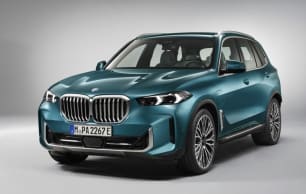A lot has changed in the new GLC… but then again, not so much so that it would alienate existing customers or fans of the midsized SUV. It's also a lot like the latest C-Class.
So, we're talking similar larger screens (12.3-inches in front of the driver and a driver-orientated 11.9-inch touch display in the centre), as well as the latest-gen MBUX system that now gains more contemporary graphics, faster responses and more natural operation – particularly the voice-control tech.
For some buyers, the move to higher-quality trim and materials is a huge step in the right direction too. There's a newfound expensiveness that no Mercedes SUV at this price point has ever seemed to possess.
It's all part of the progressive evolution of the previous GLC's interior that loses none of the old strong points: great ventilation, excellent storage and brilliant front seats being the definitive items that carry through, albeit improved where necessary in their own ways.
Traditionalists will also likely appreciate the old-school Benz touches – namely the eternal door-mounted electric seat switches and column-mounted gear shifter.
While the GLC's 2888mm wheelbase is slightly longer than before, all that extra interior space is located from the back of the front seat to the rear wheel arch, benefitting the rear-seat occupants. That said, a lack of room is definitely not a problem for people sitting up front, since there's heaps of seat travel as well as ample space for head and shoulders.
Along with how pleasing the driving position is, owners of the new GLC should appreciate how much easier and more intuitive everything is to use, compared to before. It's now far less intimidating and much more user friendly.
For instance, with just a simple scroll of a button, the instrument dials can be altered to various completely different styles to match your mood. A favourite is the elegant minimalist version that brings an analogue clock to the fore, just like you'd find in a 1970s Mercedes W116 S-Class; Das ist sehr cool!
And, of course, you'll find superb audio sound quality, a digital radio, plenty of USB ports for your devices, Apple CarPlay/Android Auto connectivity and a wireless smartphone charger. The brilliantly high-resolution MBUX multimedia screen's menus are simple to recognise and use, and most without the need to get lost in a sea of sub-menus. It's all very smart, fancy and effective.
Our test GLC 300 in Spain was fitted with the optional Airmatic air suspension system and 19-inch wheel package, and this combo makes the cabin seem quieter and more isolated than any previous iteration ever managed to be.
Moving to the rear seat, I'm sat behind myself in my usual driving position, and there's plenty to like here. There's ample space, very comfortable seats, a greater sense of luxury and quality compared to before. Additionally, most expected amenities are present, including deep door bins, face-level air vents, overhead lighting, grab handles, coat hooks, map pockets and a folding centre armrest with sliding cupholders.
About the only disappointment is that the rear backrests do not slide or recline should you be in the mood for a quick snooze.
Finally, the gesture-actuated electric tailgate opens up tall and wide, to reveal a usefully large load area.
One of the most useful advances in the new GLC is its cargo capacity boost: at 620 litres VDA, that's an additional 70L over the old model in European spec, and rises to a very reasonable 1680L with the rear backrests folded (if desired, remotely, of course), making it a better family car than before.

